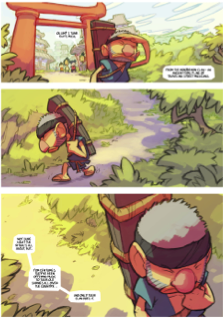Kevin Merriman and Professor Ryan Woodward, Department of Visual Arts
Why I chose to make a comic book
Besides the fact that this is something I’ve fantasized doing since I was a kid, this was also the perfect project for me to help propel my career forward as an artist. As a student, it’s easy to get caught up in finishing assignments for the sake of getting a good grade – and as an art student, this can become a very dangerous thing. Having more complete thoughts and finished products speak much louder to potential employers, and when art students are too focused on finishing something just for a grade, they risk not having things in their portfolio that will help them stand out and push their careers forward.
How I made the comic book
The simplest way I can describe my approach to making the graphic novel is the same way you would make a movie. Before you begin filming, you need a script, a cast of characters, sets, and a director to decide how to film all of it. The fun thing about being a comic artist is you get to do everything. I wrote the script, casted my own characters, built all my sets, and got to choose how to film each scene, only I did this all with a pencil and paper. After drawing all my scenes out, I scanned them into the computer and colored them all digitally. Both before and during the drawing and coloring process, I’m constantly doing research, looking at reference into inform my drawings, reading books on storytelling and color theory, and constantly trying to make the overall experience feel like a cohesive whole.
To self-publish and print the book, I simply created a PDF of my book, uploaded it to a print-on- demand service owned by amazon.com (createspace) and in just a matter of a few days it was processed and made available almost world wide for the masses. When you order a book from a print-on-demand service, it is printed and shipped upon ordering, rather than the traditional model where a limited number is printed and made available to order.
What has happened since I made the comic book
I was able to get a preview of Mariachi-Dachi into a a comic anthology (a collection of comics and illustrations) which was put together by BYU alumni and students. This anthology was brought to the CTN expo (a high profile networking convention for animators and illustrators of all kinds) where we were able to get the anthology into the hands of recruiters of animation and video game studios.
I attended the expo, and had plenty of copies of Mariachi-Dachi on hand to sell and use as a portfolio for potential employers. Some were impressed enough that I was offered jobs to work on their own developing comic projects. Mariachi-Dachi helped me stand out from the rest of the crowd, and continues to do so as I follow leads on employment. I have plans to pitch Mariachi-Dachi as an animated series to Nickelodeon, and no matter what happens I’m confident it will lead to more work and will continue to help establish my career as an artist.
Things I didn’t expect about making a comic book
Originally, this project was meant to strictly be a portfolio piece to help me find employment and further my career. Once I was done, I realized I also had a finished product that others could buy. After using all my social networking resources, such as facebook, twitter, blogs, and so forth, I started to get a sense of how persistent an independent comic artist needs to be to promote their comic, and themselves. Making a comic book was the most work I’ve ever put into any single creative endeavor, and since there’s so many voices trying to be heard in the marketing world (some with lots of money to back them up) you have to put in just as much effort in marketing/promoting as you do creating your work.
As far as the look of the comic book is concerned, I intended to have my final linework feel more loose and sketchy as a stylistic preference. However, I learned that my rough layouts were so well defined that when I moved to doing the final linework, there was less opportunity for my pencil to explore and have that sketchy energetic feel that I originally intended. I’m still pleased with how everything game together, but is an interesting learning point I wasn’t expecting.
Mariachi-Dachi is available for purchase at the following links:
- CreateSpace – https://www.createspace.com/3952667
- Amazon – http://www.amazon.com/dp/0615677967/
Mariachi-Dachi was also displayed on the 5th floor of the Harris Fine Arts Center at BYU as my BFA show during the month of November, 2012.
I also had the privilege of working with my little brother Kyle, in writing the final version of Mariachi-Dachi.
Merriman, Kevin, and Kyle Merriman. Mariachi-Dachi. 1. El Segundo: The Grey Ninja, 2012. 23. Print.

